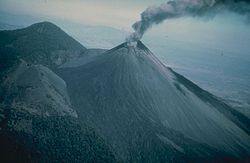Complex volcano
This article needs additional citations for verification. (March 2016) |

Homa Mountain, Kenya
in 1994


A complex volcano, also called a compound volcano or a volcanic complex, is a mixed landform consisting of related volcanic centers and their associated lava flows and pyroclastic rock.[1] They may form due to changes in eruptive habit or in the location of the principal vent area on a particular volcano.[2] Stratovolcanoes can also form a large caldera that gets filled in by a lava dome, or else multiple small cinder cones, lava domes and craters may develop on the caldera's rim.[2][3]
Although a comparatively unusual type of volcano, they are widespread in the world and in geologic history.
Yukon Territory is another example of a Cenozoic (Eocene
) caldera complex.
Examples
- Akita-Yake-Yama(Honshū, Japan)
- Asacha (Kamchatka Peninsula, Russia)
- Asama (Honshū, Japan)
- Kusatsu-Shirane (Kusatsu, Gunma, Japan)
- Banahaw (Luzon, Philippines)
- Bennett Lake Caldera(British Columbia/Yukon, Canada)
- Cumbre Vieja (Canary Islands, Spain)
- Mount Edziza volcanic complex (British Columbia, Canada)
- Galeras (Colombia, South America)
- Grozny Group (Kuril Islands, Russia)
- Hakone (Japan)
- Homa Mountain(Kenya)
- Irazú Volcano (Costa Rica)
- Ischia (Italy)
- Kelimutu (Flores, Indonesia)
- Las Pilas (Nicaragua)
- Long Valley Caldera (California, United States)
- Mount Marapi (Indonesia)
- Mount Mazama (Oregon, United States)
- McDonald Islands (Indian Ocean, Australia)
- Mount Meager massif (British Columbia, Canada)
- Morne Trois Pitons(Dominica)
- Moutohora Island (New Zealand)
- Pacaya (Guatemala)
- Puyehue-Cordón Caulle (Chile)
- Rincón de la Vieja Volcano (Costa Rica)
- Silverthrone Caldera (British Columbia, Canada)
- St. Andrew Strait (Admiralty Islands, Papua New Guinea)
- Taal Volcano, (Batangas, Philippines)
- Mount Talinis, (Negros Oriental, Philippines)
- Taupo Volcano, (Taupo, New Zealand)
- Teide, Canary Islands[4]
- Three Sisters (Oregon) (Oregon, United States)[2]
- Te Tatua-a-Riukiuta(Auckland, New Zealand)
- Tongariro, (New Zealand)
- Vesuvius, (Italy)
- Valles Caldera (New Mexico, United States)
- Yellowstone Caldera (Wyoming, United States)
See also
- Volcanic field – Area of Earth's crust prone to localized volcanic activity
- Volcanic group – Collection of related volcanoes or volcanic landforms
References
- ^ "Dieng Volcanic Complex – Volcano World – Oregon State University". volcano.oregonstate.edu. Oregon State University. 29 September 2010. Retrieved 2016-03-21.
- ^ ISBN 9781615301065.
- ISBN 9780716789291.
- ISBN 978-3-642-25892-3.

